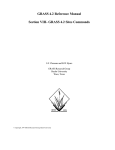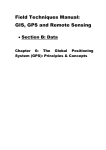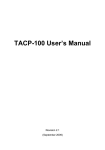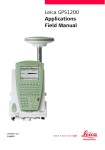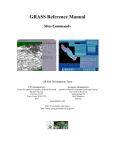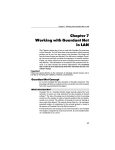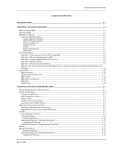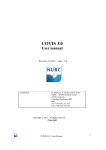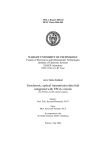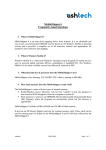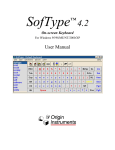Download GEON LiDAR Workflow (GLW) Users Guide
Transcript
GEON LiDAR Workflow (GLW) Users Guide Joshua Coyan Christopher Crosby Ramón Arrowsmith School of Earth and Space Exploration Arizona State University 24 October 2007 http://lidar.asu.edu Table of Contents About LiDAR ................................................................................................................ 2 Getting Started - Register for a GEON and LiDAR account and log in .................... 3 Registering with GEON .............................................................................................. 3 Accessing the GEON LiDAR Workflow ..................................................................... 7 (Optional) Customize your portal .............................................................................. 10 Information about the datasets currently available in the GEON LiDAR Workflow ..................................................................................................................................... 11 Northern San Andreas Fault (NSAF), CA Data Set.................................................... 11 Western Rainier Seismic Zone, WA Data Set ............................................................ 11 Fault Systems in the Eastern California Shear Zone (ECSZ)...................................... 12 B4: Southern San Andreas Fault................................................................................ 13 Dataset tutorials—How to process and download data in the GEON LiDAR Workflow..................................................................................................................... 14 Navigating to the different datasets............................................................................ 14 NSAF and West Rainier Seismic Zone Data Sets Tutorial ......................................... 16 Eastern California Shear Zone data set Tutorial ......................................................... 30 B4: Southern San Andreas Fault data set Tutorial...................................................... 33 Job management........................................................................................................ 36 Glossary of Symbols.................................................................................................... 39 1 About LiDAR Light Distance and Ranging (LiDAR) or Airborne Laser Swath Mapping (ALSW) data has become readily available as both technologies have increased and the emergence of Geoinformatics has occurred. LiDAR data is collected by use of an aircraft that is outfitted with a kinematic GPS, an inertial measurement unit, and a pulsed laser ranging system. The combination of these three mechanism work in unison to produce billions of measurement of x, y, and z coordinates of the ground surface and vegetation cover. This data is referred to as the ‘Point Cloud’ (Crosby, 2006). Due to the potentially large size of such data sets it can be difficult to both make the data available to others and to model such large data sets in a meaningful way. The GEON LiDAR Workflow (GLW) provides a window to a user-defined selection of raw data that may be modeled into unique, user-defined DEMs or visualizations. The GLW can do this by democratizing the data though multiple super computers. This approach provides a useful avenue to share data and to model cyber infrastructure and information technology. A generalized aerial LiDAR acquisition and processing workflow consists of the following four steps: 1) Data acquisition, 2) processing of laser ranging, GPS and IMU data to generate LiDAR point cloud, 3) point cloud classification and 4) generation, manipulation, and delivery of digital ground and vegetation models (Crosby, 2006) For more information about LiDAR refer to: Crosby, Christopher J. A Geoinformatics Approach to LiDAR Data Distribution and Processing with Applications to Geomorphology. Master’s Thesis, Arizona State University, August 2006. http://activetectonics.la.asu.edu/GEONatASU/index.htm http://lidar.asu.edu 2 Getting Started - Register for a GEON and LiDAR account and log in This portion of the manual will guide you through setting up an account for GEON, setting up an account for LiDAR, and will briefly discuss some options you may come across. In order to use the GEON LiDAR you will need to register with both GEON and register with LiDAR. Registering with GEON Step 1 In the address bar of your browser type in- www.geongrid.org This is the intro page for GEON. This is a good location to learn more about GEON and LiDAR by clicking on the About, Research, Resources, Educational, and Tutorials tabs. Step 2 Click on the Portal Tab shown below. This tab will take you to the login screen. Click here to enter 3 Step 3 The portal grants access to the GEON resources and GEON tools. The portal also provides a private workstation where you can queue jobs and return to access them again and again. To learn more about the GEON portal click on the Portal Info Tab shown below. In order to have access to the GEONgrid each user must register by clicking the Request an Account link shown below. If you already have an account simply type your username and password into the appropriate box to gain access. Click here for Portal Information Click here if you have not requested an account and need to register. Step 4 This screen requires you to enter information about yourself. Notice, you must enter your first and last name and email address, these fields are required. You must enter a valid email address in order to receive further instructions to login. When you have entered the appropriate information click Continue. 4 Step 5 A confirmation screen will appear with the information you entered. Take a moment to review your information and see that it is correct, if it is correct click Submit if it is not correct click Edit Request, which will return you to the previous screen. When you have completed your request, a screen will appear like the one shown below. You will receive an email from [email protected] with further instructions. You can close this window in your browser. 5 Step 6 Go to your email account and open the email sent from [email protected]. Click on the link in this email or copy and paste the address into the address bar of your browser. This should take you to a page similar to the one shown below. Re-enter your email address. Step 7 After you have entered your email address a new screen like the one shown below will appear. You will need to choose a password and enter it into the appropriate fields, click Submit. You will receive a message indicating that your account is awaiting administrative approval. You can now log in and use the GEONgrid. To login, type your username and password into the appropriate fields on the right hand side of the screen and click Login. You may wish to have your username and password remembered, if so check the box. 6 Accessing the GEON LiDAR Workflow Step 8 Once you have logged into GEON portal, you should see a screen like the one shown below. To access the LiDAR data set, click on the Tools tab shown below. Click here to access the LiDAR registration page and tool. Step 9 This will take you to a screen like the one shown below. This screen is a menu of GEON tools available for use; for more information about each tool click on the appropriate link. To access the LiDAR Workflow, click on the GEON LiDAR link shown below. Click here to access the LiDAR registration page and tool. 7 Step 10 It is now possible to use the LiDAR workflow trial version. To use the trial version, which limits the user to 5 million points per query, see the Data and Tutorials sections of this user’s manual. In order to register for an account that will allows 50 million points per query it is necessary to fill out the form shown below (red box), when you are finished click Submit. Note that we have this second layer of authentication because we are using US Teragrid compute resources (http://www.teragrid.org). We take advantage of the GEON portal role-based authentication capabilities to manage resource use accordingly. Give this a try and if you need more, contact the GLW development team ([email protected]) and we can up your point limit. 8 Once you have completed the form you should see a screen that looks like the one shown below. Expect to receive an email from the GLW reviewers within 24 hours. While you are waiting, feel free to run some jobs and get used to the GLW. The next time you return to the LiDAR page the registration form will not be a part of the screen and you can now directly access the data sets. For information on how to access the data sets see the Data and Tutorial sections of this User’s Manual. 9 (Optional) Customize your portal Step 11 From the GEON portal shown below, click the UserProfile tab. In this tab you can edit your account information, change your password, and customize your workstation. To add a LiDAR Workflow tab to your workstation click the box next to LiDAR as shown below. Then click Save. Click here to add a LiDAR tab to your workstation. You should notice that a tab entitles LiDAR is now be located on the top of the screen as shown below. New LiDAR workstation Tab From the GEON portal, you can now click on the LiDAR tab to come directly to the LiDAR portal. 10 Information about the datasets currently available in the GEON LiDAR Workflow Northern San Andreas Fault (NSAF), CA Data Set The Northern San Andreas Fault data set features data along the Northern San Andreas fault and associated marine terraces in coastal Sonoma and Mendocino counties, California. This data set covers approximately 418 square kilometers and includes approximately 1.2 billion data points. Point density is 1.2 points per square meter. This airborne laser swath mapping data was acquired in support of collaborative research by members of the U.S. Geological Survey (USGS)and the National Aeronautics and Space Administration (NASA), with funding provided by NASA's Earth Surface and Interior Focus Area. The data were acquired and processed by TerraPoint, LLC under contract to NASA's Stennis Space Center. The data are in the public domain with no restrictions on their use. Projection: State Plane Zone for San Andreas: California II Horizontal units: US Survey Feet (= 1200/3937 meters ~ 0.30480061 meters) Elevation units: International Feet (= 0.3048 meters) Spheroid: GRS80 Horizontal Datum: NAD83, 1991 Adjustment Vertical Datum: NAVD88 Orthometric elevations are derived from ellipsoid elevations using the National Geodetic Survey geoid model Geoid99 (https://portal.geongrid.org:8443/gridsphere/gridsphere?gs_action=lidarNSAF&cid=215) Western Rainier Seismic Zone, WA Data Set The Western Rainier Seismic Zone data set features data from the western Rainier seismic zone, adjacent to Mt. Rainier, in Pierce County, WA. This data set covers approximately 325 square kilometers and includes approximately a billion data points. Point density is approximately 2 points per square meter. For more information on these data please go to: http://gsa.confex.com/gsa/2003AM/finalprogram/abstract_67004.htm. This airborne laser swath mapping data was acquired in support of collaborative research by members of the U.S. Geological Survey (USGS)and the National Aeronautics and Space Administration (NASA), with funding provided by NASA's Earth Surface and Interior Focus Area. The data were acquired and processed by TerraPoint, LLC under contract to NASA's Stennis Space Center. The data are in the public domain with no restrictions on their use. 11 Projection: State Plane Zone: Washington North Horizontal units: US Survey Feet (= 1200/3937 meters ~ 0.30480061 meters) Elevation units: International Feet (= 0.3048 meters) Spheroid: GRS80 Horizontal Datum: NAD83, 1991 Adjustment Vertical Datum: NAVD88 Orthometric elevations are derived from ellipsoid elevations using the National Geodetic Survey geoid model Geoid99 (https://portal.geongrid.org:8443/gridsphere/gridsphere?gs_action=lidarRainier&cid=215) Fault Systems in the Eastern California Shear Zone (ECSZ) The Fault Systems in the Eastern California Shear Zone (ECSZ) contains data acquired by the National Center for Airborne Laser Mapping (NCALM) on behalf of Dr. Mike Oskin (UNC) and Dr. Lesley Perg (U of M)) as part of their NSF project on fault systems in the Eastern California Shear Zone. They have kindly agreed to make these data available to the research community through the GEON LiDAR Workflow. Grid Coordinate System Name: Universal Transverse Mercator UTM Zone Number: 11 N Transverse Mercator Projection Scale Factor at Central Meridian: 0.999600 Longitude of Central Meridian: -117.000000 Latitude of Projection Origin: 0.000000 False Easting: 500000.000000 False Northing: 0.000000 Planar Coordinate Information: Planar Distance Units: meters Geodetic Model Horizontal Datum Name: D_WGS_1984 Ellipsoid Name: WGS_1984 (https://portal.geongrid.org:8443/gridsphere/gridsphere?gs_action=lidarECSZ&cid=215) 12 B4: Southern San Andreas Fault The B4: Southern San Andreas Fault Data Sat offers access to LiDAR point cloud data of the southern San Andreas Fault acquired by the National Center for Airborne Laser Mapping (NCALM) through funding from the National Science Foundation (NSF) as part of the "B4 Project". The B4 Project has kindly agreed to make these data available to the research community through the GEON LiDAR Workflow. If you utilize the B4 data for talks, posters or publications, we ask that you acknowledge the B4 project. Grid Coordinate System Name: Universal Transverse Mercator UTM Zone Number: 11 N Transverse Mercator Projection Scale Factor at Central Meridian: 0.999600 Longitude of Central Meridian: -117.000000 Latitude of Projection Origin: 0.000000 False Easting: 500000.000000 False Northing: 0.000000 Planar Coordinate Information: Planar Distance Units: meters Geodetic Model Horizontal Datum Name: D_WGS_1984 Ellipsoid Name: WGS_1984 (https://portal.geongrid.org:8443/gridsphere/gridsphere?gs_action=lidarB4&cid=215) 13 Dataset tutorials—How to process and download data in the GEON LiDAR Workflow Navigating to the different datasets Note: Current Interface with the LiDAR/ALSM Data Processing is not compatible with Internet explorer 7. We are working on a solution. You may need to uninstall Internet Explorer 7, see Microsoft Help for more information. Step 1 After you have requested an account and logged into the GEON Portal (if you have not completed these steps see the Getting Started section of this manual). Click here to access the LiDAR Workflow link I you have customized your workstation; you can click here to access the LiDAR Workflow data set (see the Getting Started section of this manual). Skip to step 3. 14 Step 2 Click on the GEON LiDAR link below. Click here to access the LiDAR data set. Step 3 This page contains links to the four data sets offered by the LiDAR Workflow. When you see the symbol you can click on them to receive more information concerning the topic that the symbol is in front of. Click here to access the NSAF data set. Click here to access the West Rainier data set. Click here to access the ECSZ data set. Click here to access the B4 Southern SAF data set. 15 NSAF and West Rainier Seismic Zone Data Sets Tutorial How to download data from the Northern San Andreas Fault, CA or West Rainier Seismic Zon data set This portion of the manual will guide you through downloading data from the Northern San Andreas Fault, CA data set (NSAF) as an example. All of these instructions apply for the West Rainier data as well. Step 4 This page contains information about the NSAF LiDAR data set and provides the spatial selection window. Click here to see the area that contains downloadable data. Click here for specifications about the NASF data set. 16 Step 5 Selecting the Data This page contains the spatial selection tool for the LiDAR NSAF data set. There is two ways to select the data you want. The first is you can use the Select area to zoom ( the magnifying glass) tool to zoom to the area you are interested in and then use the Select tool to select the data points. Click here to add/ remove towns. Click here to add/ remove faults. Click here to add/ remove roads. Click here to add/ remove the data extent. The stippled pattern on the map is the area that contains data. Click here to add/ remove water. Click here to add/ remove the DEM. Click here to add/ remove the underlying landsat image. Back to previous view Jump to next view Location of mouse Select are to zoom Zoom out Go to home view 17 Click to drag and pan Selection tool After you have zoomed to the area of interest and selected the area that you would like to download data from, information will appear below the selection tools informing the user about the specific of the download. If there is an error or the request is too large you will be informed so you can make the necessary adjustments. Note: If there is more than 1.6 million points selected you will receive a warning that states: Warning, the selection area contains more than 1.6 million points. Currently, interpolation of points to an elevation product is limited to 1,600,000 points for the spline algorithm. The local binning algorithm is limited to 100,000,000 points. This limit does not apply to downloads of point cloud data. If you'd like to download the point cloud data for this selection, choose only the "download raw data" option below and submit your request. 18 If you would like the DEM Generation via Spline Interpolation Algorithm option for download, you can only have 1.6 million data points selected. For all other options you can choose up to 50 million points. More about these options below. The second method for selecting data is used if you know the California Data Set Coordinates of the area you would like to select. Enter the coordinates into the Data selection coordinates section shown below. It is an option to choose which type of data you would like to download. Failure to select a classification type results in all classifications being returned. Classification selection tool Note: The numbers in the Data selection coordinates boxes will also reflect which area is chosen from the navigation map above. 19 Step 6 Downloading the Data: Point Cloud Data Download After you have selected the data you want, now you need to specify how you want the data sent. The next few pages of this tutorial will go through each option and what it means. You may also want to check the Glossary pages of this tutorial if you need further clarification or more information. Selection of this option returns the LiDAR point cloud for the area selected as a compressed ASCII file (comma delimited, one point per line). This is the perfect option if you only wish to download the raw data. It is not necessary to select any of the other options below. You can skip the rest of the screen and jump to the bottom. When you have completed your selection you will want to enter a job title and a description of the job. Confirm your email address. You will receive a completion notification email when the job is complete. Click Submit to finish this order. An email will be sent to you, which contains two links, one is a link that provides a summary of the data requested including the title, description, dataset, projection, units, zone, spheroid, and coordinates. The second is a link to download the data . 20 The data that will be downloaded from selecting the Point Cloud Data/ Download Raw Data option will look like this. It contains a column for x, y, z, date, time, return number, number of zero returns that occurred, offnidar, returnint, and classification. Below is a sample of the type of data you will receive as shown in the screen capture of the data parsed in an excel spreadsheet. 21 Step 6b Producing and Downloading the Digital Elevation Model: Local Binning What does the Local Binning Algorithm do? The local binning algorithm creates a DEM using the elevation information from LiDAR returns contained within a circular search area. Red circles represent the search area, defined by the user. Grid cell node for which the DEM elevation will be calculated. The grid cell resolution will be specified by the user. Elevation information from LiDAR return. Five values are computed for each node in a grid: 1) the minimum, 2) maximum, 3) mean, and 4) inverse distance weighted mean of the local points, and 5) the number of points in the search area. For more information about each value computed click on the show details symbol beside each selection. The local binning algorithm was written by Han Suk Kim (UCSD). For more information on this algorithm please go to lidar.asu.edu and follow the Knowledge Base link. 22 When downloading the DEM Generation via Local Binning Algorithms you can choose to download all five of the computed interpolation methods, the minimum, the maximum, the mean, the inverse distance weighted and the point cloud. These are available in both Arc grid format and Ascii grid format. Select this option if you would like to download the DEM calculated using the minimum elevation in the user defined search radius. When you choose the interpolation Method, the Arc grid box will automatically be checked, you can uncheck this box if you do not prefer this option. Select this option if you would like to download the DEM calculated using the maximum elevation in the user defined search radius. The Ascii grid option will not automatically be checked, you can check this box if you would like to download the data in Ascii format. You can check both options. Select this option if you would like to download the DEM calculated using the mean elevation in the user defined search radius. Select this option if you would like to download the DEM calculated using the IDW mean elevation in the user defined search radius. The grid cell is populated with the number of points within the user defined search radius. Useful for evaluating LiDAR return concentrations. The grid resolution is the resolution of the DEM, the default DEM resolution is 6 feet. Grid resolution is set in the same units as the data set. Sets the radius of the search areas used to perform the binning algorithm. For more information go to: lidar.asu.edu/knowledge base.html To complete the request, add a title to and descriptions in the space provided and click Submit. An email will be sent to you, which contains two links, one is a link that provides a summary of the data requested including the title, description, dataset, projection, units, zone, spheroid, and coordinates. The second is a link that will take you to a webpage that will allow you to download the data you requested. The second link will take you to a page that gives an example of the file types shown and a link to information about your order and a link to download your order. 23 LiDAR Processing Workflow Outputs Processing of 14306499 points in Lidar point cloud. Min This page contains samples of the DEM’s requested and there type, the type is labeled in the upper right-hand corner. There may be numerous samples of DEMs or just a few depending on your selections. Max To download the data click on the Results link. Click on the metadata link for information about the data requested.. Below you can download an archive file (tgz format) with the results of your job Results The processing selections of your job are available at metadata. Download LViz - A free application for visualization of LiDAR point cloud and interpolated surface data developed in the Active Tectonics Research Group at Arizona State University. 24 Once you have downloaded the data, you can unzip the file using WinZip. (For the purposes of this tutorial all of the items were selected for the Local Binning Algorithms section) The file you receive will look like the following: This file contains eleven files, each item selected and a file that contains a summary of the data request. The file name is the unique request id. The file extension denotes the product requested and the file type, Arc grid (.arc.asc) or Ascii grid (.asc). 25 Step 6c Producing and Downloading the Digital Elevation Model: Spline Interpolation What does the Spline Interpolation Algorithm do? The Spline is a mathematical function that fits polynomials to data points; it is commonly used for smoothing or interpolation. It is essentially a process of fitting data points that contain x, y, and z data to a curve or plane. The Spline requires input settings of smoothing and tension from the user. If we image a two dimensional data set with x and y data points, and we are trying to fit an imaginary string through these points the smoothing setting determines how many order polynomials to use, the higher the ordered polynomial the smoother the curve. But it is also important to have a setting that determines how closely the curve will fit to the data so if we imagine the same string fastened to one end and we pulled the other end, it would become tighter and fit the data better. For instance lets look at the two-dimensional plots below. We would like to fit this data to a curve, if we use a second order polynomial; the line does not fit to closely but is very smooth. If we use a sixth order polynomial the curve matches the data better but is less smooth. The way that we fit the data to a surface is the same thing based on the settings we use. 7 7 6 6 5 5 4 4 3 3 2 2 1 1 0 0 0 2 4 6 8 10 12 0 X and Y data 2 4 6 8 10 Second-order polynomial 7 6 5 4 3 2 1 0 0 2 4 6 8 10 12 Sixth-order polynomial For more information about the program, GRASS, which runs the Spline, please go to grass.itc.it. 26 12 When downloading the DEM Generation via Spline Interpolation Algorithms you can choose to download four options with different file types, the Elevation, the Slope, the Aspect, and the Pcurv. The slope is information about the landscape and determines what the slope of each grid tile is from 0 to 90 degrees. The aspect is a determination of which direction the slope of a grid tile is facing from 0 to 360 degrees, The PCurv is the profile curvature with a numeric value assigned for concavity. These products are available in either Arc grid, Ascii Grid, or GeoTiff formats. Note you can download all products and all file types simultaneously. This option specifies that you would like to download the DEM from the Spline calculation. When you choose the DEM and products option, the Arc grid box will automatically be checked, you can uncheck this box if you prefer. This option specifies that you would like to download the Slope data. The Ascii grid option will not automatically be checked, you can check this box if you would like to download the data in this format. The GeoTiff option will not automatically be checked, you can check this box if you would like to download the data in this format. Click on this if it is a + to expand to see these options This option specifies that you would like to download the Aspect data. This option specifies that you would like to download the Pcurv data. The grid resolution is the resolution of the DEM, the default DEM resolution is 6 feet. Grid resolution is set in the same units as the data set. Sets minimum distance between points used for the interpolation. Dmin is in the same units as the data set. 27 The tension parameter tunes the character of the surface. For most landscape applications 40 seems to generate good results. This is most useful when dealing with noisy data. With the smoothing set to 0 the surface passes exactly through the data points. To complete the request, add a title to and descriptions in the space provided at the bottom of the page and click Submit. An email will be sent to you, which contains two links, one is a link that provides a summary of the data requested including the title, description, dataset, projection, units, zone, spheroid, and coordinates. The second is a link that will take you to a webpage that will allow you to download your data. The second link will take you to a page that gives an example of the file types, a link to information about your order, and a link to download your order. This page contains samples of the product requested. It is labeled in the center above the image. To download the data click on the Results link. Click on the metadata link for information about the data requested.. 28 Once you have downloaded the data, you can unzip the file using WinZip. (For the purposes of this tutorial all of the items were selected for the Spline Interpolation Algorithms section) The file you receive will look like the following: This file contains seventeen files, each item that you selected and a file that contains a summary of the data request. The file name is the unique request id. The file extension denotes the product requested and the file type, Arc grid (.arc.asc), Ascii grid (.asc), or GeoTiff (.tfw). 29 Eastern California Shear Zone data set Tutorial How to download data from the Eastern California Shear Zone data set This portion of the manual will guide you through downloading data from the Eastern California Shear Zone (ECSZ). We assume that you have navigated there following the instructions above. For the purposes of this tutorial click on the Fault Systems in the Eastern California Shear Zone (ECSZ) link shown above to access the data set. Step 4 This page contains information about the ECSZ LiDAR data set and provides the spatial selection window. Click here for specifications about the ECSZ data set. 30 Step 5 Selecting the Data This page contains the spatial selection tool for the LiDAR NSAF data set. There is two ways to select the data you want. The first is you can use the Select area to zoom ( the magnifying glass) tool to zoom to the area you are interested in and then use the Select tool to select the data points. Click here to add/ remove The areas towns. highlighted in yellow contain Click here to the data for the add/ remove ECSZ. roads. Click here to add/ remove the data extent. Click here to add/ remove the DEM. Click here to add/ remove the underlying landsat image. Back to previous view Jump to next view Location of mouse Select are to zoom Zoom out Go to home view 31 Click to drag and pan Selection tool After you have zoomed to the area of interest and selected the area that you would like to download data from, information will appear below the selection tools informing the user about the specific of the download. If there is an error or the request is too large you will be informed so you can make the necessary adjustments. Note: If there is more than 1.6 million points selected you will receive a warning that states: Warning, the selection area contains more than 1.6 million points. Currently, interpolation of points to an elevation product is limited to 1,600,000 points for the spline algorithm. The local binning algorithm is limited to 50,000,000 points. This limit does not apply to downloads of point cloud data. If you'd like to download the point cloud data for this selection, choose only the "download raw data" option below and submit your request. If you would like the DEM Generation via Spline Interpolation Algorithm option for download, you can only have 1.6 million data points selected. For all other options you can choose up to 50 million points. For information and steps for Point Cloud Data Download, DEM Generation via Local Binning Algorithms, or DEM Generation via Spline Interpolation Algorithm see Step 6 of the NSAF and West Rainier Tutorial section of this User’s Manual. 32 B4: Southern San Andreas Fault data set Tutorial This portion of the manual will guide you through downloading data from the B4: Southern San Andreas Fault (B4). We assume you have navigated to the dataset as explained above Step 4 This page contains information about the ECSZ LiDAR data set and provides the spatial selection window. Use this logo if you use the data in a presentation Click here for more information on the B4 data set. 33 Step 5 Selecting the Data This page contains the spatial selection tool for the LiDAR NSAF data set. There is two ways to select the data you want. The first is you can use the Select area to zoom ( the magnifying glass) tool to zoom to the area you are interested in and then use the Select tool to select the data points. Click here to add/ remove towns. Click here to add/ remove roads. The red line along the San Andreas Fault contains data for the B4. To see stippled pattern zoom in. Click here to add/ remove the data extent. Back to previous view Jump to next view Location of mouse Select are to zoom Zoom out Go to home view 34 Click to drag and pan Selection tool After you have zoomed to the area of interest and selected the area that you would like to download data from, information will appear below the selection tools informing the user about the specific details of the download. If there is an error or the request is too large you will be informed so you can make the necessary adjustments. Note: If there is more than 1.6 million points selected you will receive a warning that states: Warning, the selection area contains more than 1.6 million points. Currently, interpolation of points to an elevation product is limited to 1,600,000 points for the spline algorithm. The local binning algorithm is limited to 50,000,000 points. This limit does not apply to downloads of point cloud data. If you'd like to download the point cloud data for this selection, choose only the "download raw data" option below and submit your request. If you would like the DEM Generation via Spline Interpolation Algorithm option for download, you can only have 1.6 million data points selected. For all other options you can choose up to 50 million points. For information and steps for Point Cloud Data Download, DEM Generation via Local Binning Algorithms, or DEM Generation via Spline Interpolation Algorithm see Step 6 of the NSAF and West Rainier Tutorial section of this User’s Manual. 35 Job management One of the advantages of the cyberinfrastructure approach that we employ is the opportunity to watch your jobs as they progress through the GLW, to archive your jobs, and to find them again and modify them and rerun them if desired. To view access jobs submitted or status of jobs submitted click here. 36 To view a summary of your LiDAR jobs submissions click here. When you click on My LiDAR Jobs you will see a screen like the one shown below. This screen lists your submitted jobs by Id number, Dataset, Title, and Submission Date. The status of your job is also listed. You can click on the status link of each job to get a more detailed description of your job’s status. This is your unique Job Id number based on the time that you submit your request. This Id number ensures that your job will never be mixed up with anyone else. This is the data set that the selected data is from. This is the title that you chose for your job. This is the job’s unique Id number. This is the position your job is in during processing. This is the status of your job. If there is an error, click on Error to see the error. 37 This is the date and time that you submitted your request. This is the status of your request. By clicking on the link for each job you can view a detailed description of your request. An example is shown below. If you click on My Jobs Submission Info you will be taken to a screen that looks like the one shown below. This screen gives a summary of your usage history. The top section is your total usage history. The mid-section is a summary of your usage over the past week. Finally, the bottom section is your usage history over the last month. 38 Glossary of Symbols Show details, click on this symbol for more information about the topic it is adjacent to - Hide details, click on this symbol to hide the information about the topic - Expand menu - Compact menu - Interactive data selection menu - Back to previous extent - Get the next extent - Click and drag to zoom in - Click to zoom out - Reset the map to full extent - Click and drag to pan - Click and drag to set the area of interest 39








































